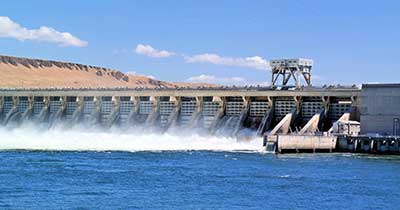Relevance: GS-2: Government Policies & Interventions, issues and challenges pertaining to the federal structure
Key phrases: Dam safety Act, centre, states, federalism, National Dam Safety Authority, States Dam Safety Authority
Why in News?
- DMK Lok Sabha member, representing Mayiladuthurai constituency in Tamil Nadu, has moved the Madras High Court challenging the constitutional validity of Dam Safety Act, 2021 on the grounds that it goes against federalism and is beyond the legislative competence of the Centre.
What is Dam Safety Act?
- It aims to “provide for surveillance, inspection, operation and maintenance of the specified dam for prevention of dam failure-related disasters, and to provide for institutional mechanism to ensure their safe functioning and for matters connected therewith or incidental thereto.”
DAM Safety Act, 2021
- The Act passed in Dec 2021 aims to help all states and
Union Territories adopt uniform dam safety procedures.
Major provisions: - A National Committee on Dam Safety with a three-year tenure, comprising the chairman of the Central Water Commission, a maximum of 10 representatives of the central government in the ranks of joint secretary, a maximum of seven representatives of the state governments, and three experts, will be formed as part of the Act.
- The National Dam Safety Authority, to be headquartered in Delhi, will be formed under the Act. It will be headed by an officer not below the rank of Additional Secretary to the Government of India to deal with problems relating to dam engineering and dam safety management.
- A state dam safety organisation will be formed as well, which will be responsible for the dam safety. This organisation is empowered to investigate and gather data for proper review and study of the various features of the design, construction, repair and enlargement of dams, reservoirs and appurtenant structures.
- The state dam safety organisation must also report events such as dam failures to the National Dam Safety Authority and also maintain records of major dam incidents of each specified dam.
- The owners of the specified dams are required to provide a dam safety unit in each dam. This unit will inspect the dams before and after the monsoon session, and during and after every earthquake, flood, or any other calamity or sign of distress.
- All dams in India with a height above 15 metres come under the purview of the bill.
State’s objection on the Act:
- As per the Act the control of the National Committee on Dam Safety and the National Dam Safety Authority comes under the Central Government. Appointing States' representatives and specialists is also coming under the Central Government. But this Bill takes away these rights falling with States.
- Entry 17 of the State List provides for the States to make laws with regard to water supplies, drainage and embankments, water storage and water power subject to Entry 56, which is the Union List. According to Entry 56, the Parliament can make laws on regulation of inter-State rivers and valleys. However, it does not have power to regulate intra-State water, rivers and valleys.
- Entire Act does not provide representation to the owner of the dam in the National Committee or the State Dam Organisation.
- The Act contended on certain terms, including the word ‘dam’ in the Act, had been deliberately defined vaguely to give unbridled power to the Centre to treat any dam as a ‘specified dam’. He also feared that if those definitions were followed, almost all dams in the country would fall under the purview of the Act.
- If not nullified, it would have an adverse impact on agriculture, fisheries, hydro power generation, provision of drinking water to the people and so on.
- States also pointed out that the Act provided for criminal prosecution for not obeying directives issued under the legislation. “State authorities have to face the music under Section 41 if the directions of the Union authorities are not obeyed... Bureaucrats will now be kept under fear and threat which will lead to mechanical compliance of the dictates of the Union Government.
Way Forward:
- Dams in India are constructed and maintained by the states. Some dams are also maintained by autonomous bodies. The Centre came up with the Dam Safety bill in 2019 against the backdrop of over 5200 large dams in India.
- The dam security is an issue of concern because of the lack of legal and institutional architecture. Unsafe dams are a hazard and they may break and also cause disasters. This is the major reason for the Dam Safety Act to be brought about.
- The Act is being opposed by many states especially Tamil Nadu. It is being opposed as the Centre has not considered the ideas of the states.
- So, there is a need to balance these issues and centre must admire the concern of the states.
- Consultations with states which are likely to be most affected and taking them in confidence is important.
Source: The Hindu
Mains Question:
Q. The Dam Safety Bill was passed by Parliament recently amid strong objections from the states, this brought the issue of federalism. So what is federalism? Discuss various concerns of states’ on Dam Safety Act? Critically examine.








